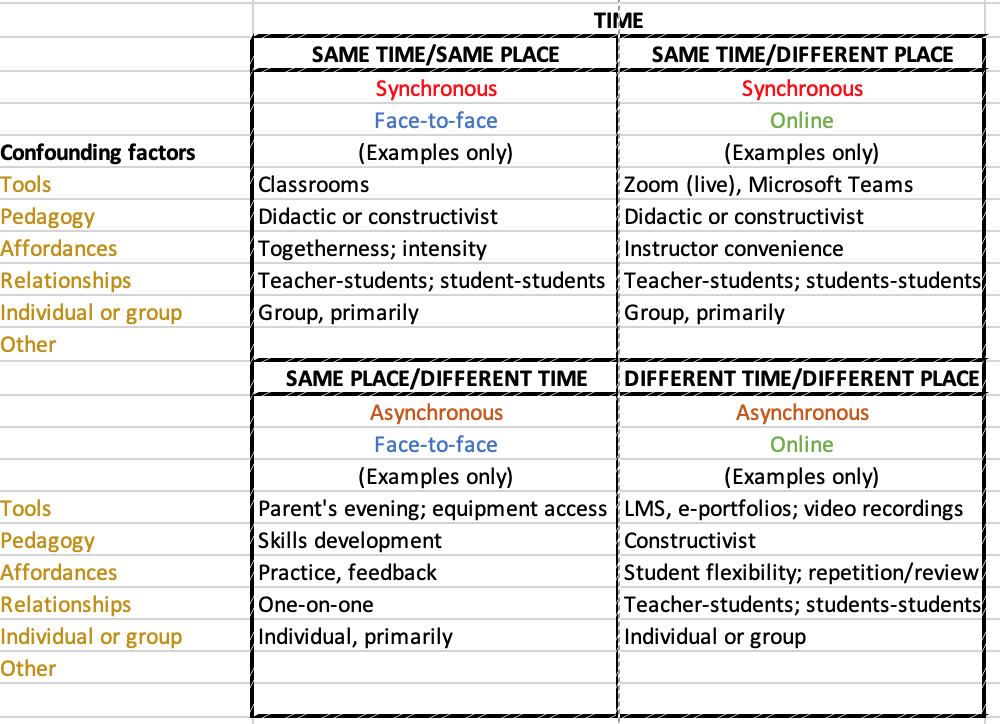
Binary thinking
There are two kinds of people: those who divide people into two groups; and those who don’t. Both humans and computers seem more comfortable with binary divisions: on or off, right or wrong, black or white, happy or sad, Republican or Democrat. It makes life simple.
Unfortunately, though, life is in fact complicated. So it is not surprising that the division between synchronous and asynchronous learning fails to take into account the complexities or the nuances of online learning (or face-to-face teaching).
In an earlier post, “Why, ‘logically’, online learning is superior to face-to-face teaching“, I argued that online learning can combine both synchronous and asynchronous learning, while by definition face-to-face teaching is synchronous (although as one reader has pointed out, face-to-face teaching is often combined with non-digital asynchronous learning, such as reading books for homework – or swotting.)
As I always say about making comparisons in education, no one teaching method, medium or mode of delivery is intrinsically ‘better’ than another; it is the conditions in which they are used that matter, so we need to understand the conditions that are necessary for success in teaching and learning. This applies just as much to the choice of synchronous or asynchronous teaching methods, whether online or not.
Confounding factors
We need to look at the range of factors that can influence learning as well as the synchronicity or otherwise of teaching and learning, and how these other factors fit with either synchronous or asynchronous learning. This is where things start to get complicated. What are these factors?
Time and place
Synchronous learning requires everyone to be together at the same time, but not necessarily in the same place. Asynchronous learning takes place at both different times and at different places.
Face-to-face or online
We have seen that face-to-face is primarily synchronous, although asynchronous elements can be added but not integrated in terms of time, while online learning is primarily asynchronous, although synchronous elements (such as a Zoom session) can be added.
Tools or technology
Certain tools are more often used with synchronous learning, while other tools are more often used for asynchronous learning. For instance, the classroom can be considered the primary technology of synchronous, face-to-face teaching, and the learning management system an important (but not the only) technology for asynchronous online learning. Some technologies (such as Zoom) can be used either synchronously or (through recording and streaming) asynchronously.
Pedagogy
Although certain pedagogies may be more often found in either synchronous or asynchronous learning, these types of delivery are really agnostic when it comes to pedagogy.
For instance, either can be used for didactic/objectivist teaching, or for more conversational/constructive approaches. Pedagogy will depend on the specific learning outcomes and the demands of the subject matter (as well as instructors’ comfort level). In other words, most pedagogical approaches can work either synchronously or asynchronously, but it is really necessary to examine this case by case.
Affordances
By this, I mean what educational purposes does either synchronous or asynchronous learning best lend themselves to? Let me give an example. One of the best ways to get children to learn to read is through parents reading to them in bed. This is clearly a synchronous, face-to-face learning activity, but what makes it so powerful?
In this case, it is love/togetherness, and the intensity of the experience. But not all synchronous learning activities have this feeling of togetherness and intensity. This might be a main criticism of Zoom lectures delivered synchronously individually to students in their homes; there is little sense of ‘togetherness’ or intensity – although, as always, a skilled instructor may be able to design his or her teaching deliberately to achieve these affordances.
Other ‘affordances’ might include the ability to give timely and relevant feedback, flexibility for students, convenience for instructors or administrators, and so on.
Relationships
Individual or group learning is another factor. In fact it is more than this; it is a question of the relationship between instructor/teacher and students, and between students themselves. So we can have one-on-one teacher:student; one teacher to many students; one teacher to several groups of students; individual students to other individual students; or students working in a group. Again most of these relationships can be either synchronous or asynchronous, but in some cases one will be more convenient than the other.
There are probably other factors that need to be considered as well, but my purpose here is to show the foolishness of assuming that synchronous is better (or worse) than asynchronous learning or that face-to-face teaching is better (or worse) than online learning. It all depends on the conditions.
To help clarify this, see Figure 1 below:

Conclusions
- What makes sex more fun than swotting? Togetherness/love and the intensity of the experience: sex is much better synchronously and in the same place, but other factors have to be right too. (Well, that’s my experience – yours may be different).
- You can see that teaching is more of an art than a science. It’s a question of getting the best combination of a wide variety of factors, all of which can have bearing on the learning process.
- It seems to me that in terms of teaching effectiveness, it’s difficult to argue that synchronous learning is clearly better than asynchronous learning (or vice versa). It will depend on context and conditions. In other words there is a high level of substitution possible.
- However, it is important to ensure that if you are making a claim that synchronous or face-to-face learning provides affordances that are difficult to provide asynchronously or online (or vice versa), you deliver on that promise.
- In a pandemic, when face-to-face learning is highly dangerous, a switch to online learning should not result in inferior learning, if the right conditions can be put in place. However, there will be some instances where it will be very difficult to replicate or replace online some of the conditions for successful learning, especially for younger children, such as love and empathy.
This is just a first attempt on my part to understand the differences between synchronous and asynchronous learning, and between face-to-face and online learning. My worry is that much of what I have written is based on personal experience and not on hard research data (because this is indeed a relatively new area of inquiry).
My goal therefore is to open up a discussion of these issues, because I am concerned that positions are already being taken based on false premises. So please let me have your comments in the comment box below.









 Dr. Tony Bates is the author of eleven books in the field of online learning and distance education. He has provided consulting services specializing in training in the planning and management of online learning and distance education, working with over 40 organizations in 25 countries. Tony is a Research Associate with Contact North | Contact Nord, Ontario’s Distance Education & Training Network.
Dr. Tony Bates is the author of eleven books in the field of online learning and distance education. He has provided consulting services specializing in training in the planning and management of online learning and distance education, working with over 40 organizations in 25 countries. Tony is a Research Associate with Contact North | Contact Nord, Ontario’s Distance Education & Training Network.


I think the term ‘face to face’ is itself a source of confusion as student and teacher can be F2F synchronously online as well. There are faces there after all (as long as cameras are turned on). What is meant by the term, I think, is ‘in-person’ or ‘on campus’ or ‘in school’.
The ‘sex’ analogy is becoming more tenuous in our digitally dominant early 21st century with the advent of cyber sex etc. As you say, it all depends on one’s experience.
Really enjoy your work.
Thanks, Stuart
You are absolutely right. In-person is a much better term. I will use that in future.
Mr. Bates,
I’ve been a follower of yours for so long.
Thanks for the inspiration, contribution and your e-leadership to us, instructors, and e/learning designers and centers at the same time.
Agreed with your arguments on a/sync. instruction. No one denies this chart that we see here on the page (including seasoned faculty who need improved instruction in their courses). Though, as you specialize in learning/teaching enhancement particularly in the college/university level, self-efficacy, open-mindedness and adoption of innovations are some hot topics that need giving priority while aiming to improve the faculty performance. There is a need for hard research data and practical solutions (and ‘sme’ [your] advice) on this, too.
Looking forward to learning more from you.
Best